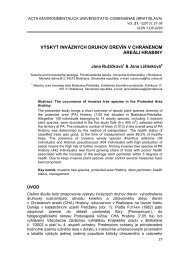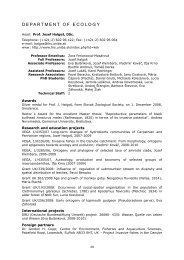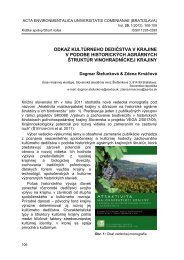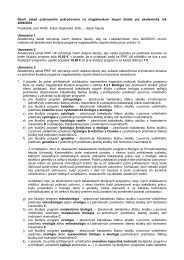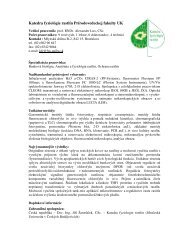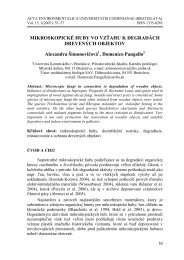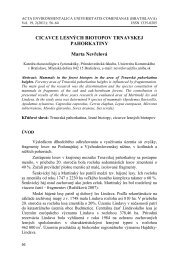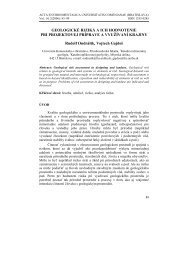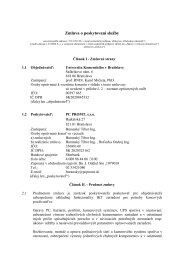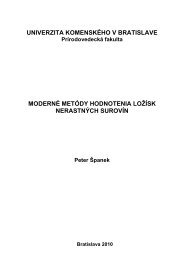UNIVERZITA KOMENSKÉHO V BRATISLAVE VZÁCNOPRVKOVÁ ...
UNIVERZITA KOMENSKÉHO V BRATISLAVE VZÁCNOPRVKOVÁ ...
UNIVERZITA KOMENSKÉHO V BRATISLAVE VZÁCNOPRVKOVÁ ...
You also want an ePaper? Increase the reach of your titles
YUMPU automatically turns print PDFs into web optimized ePapers that Google loves.
of Nb-Ta minerals (manganotantalite III, manganocolumbite III, ferrotapiolite III and<br />
ferrowodginite III) most likely formed during the final stage of the pegmatite<br />
consolidation and it is characterized by increase of Mn/(Mn+Fe) ratio. Microlite as well as<br />
secondary phenakite and bertrandite, represent the youngest phases which formed<br />
probably during a post-magmatic, low-temperature, hydrotermal overprint of the Jezuitské<br />
lesy granitic pegmatite.<br />
Accessory Nb-Ta oxide minerals were identified in pegmatitic leucogranite near<br />
Duchonka, at the ridge between Lipová and Soľnisko hill, Považský Inovec Mts.. Studied<br />
granite is a medium to coarse-grained leucocratic rock, which consists of quartz, Kfeldspar,<br />
plagioclase (An04–28), biotite and muscovite, with accessory garnet (almandine –<br />
spessartine) and fibrolitic sillimanite, rarely zircon, apatite, monazite and identified Nb-Ta<br />
minerals. It can be geochemically characterized as relatively highly fractionated granites<br />
with S-type characteristics.<br />
Ferrocolumbite to ferrotantalite forms discrete tabular crystals 30-350 μm in size,<br />
in association with quartz, alkali-feldspar, muscovite and sillimanite. The mineral<br />
commonly shows progressive zoning with central parts enriched in Nb (ferrocolumbite)<br />
and rims enriched in Ta (ferrotantalite). However, irregular convoluted zoning of border<br />
parts, as a result of the late-magmatic to subsolidus dissolution-reprecipitation processes<br />
are also present, or a reversal trend of zoning with decrease of Ta towards to border parts<br />
of the crystals was detected. The composition of columbite-(Fe) to tantalite-(Fe) shows a<br />
relatively constant Mn/(Mn+Fe) = 0.20-0.27 (locally 0.35-0.40), but an extreme range of<br />
Nb-Ta fractionation: Ta/(Ta+Nb) = 0.18-0.72. Moreover, group of analyses in the rim<br />
zones of the tantalite crystals attain Ta/(Ta+Nb) ratio over 0.63 value and pass to the field<br />
of the miscibility gap between tantalite and tapiolite. Contents of Ti, W, Sn, Mg and other<br />
elements in columbite-group minerals are low. Titanium attains mostly about 0.5 wt.%<br />
TiO2 and a slightly decrease of Ti with increasing values of Ta/(Ta+Nb) was recorded.<br />
Ferrotapiolite forms discrete irregular or shortly prismatic crystals, ca. 15-75 μm in size,<br />
in association with quartz and sillimanite. Ferrotapiolite displays slightly irregular<br />
compositional zonality in BSE with Mn/(Mn+Fe) = 0.03-0.04 and Ta/(Ta+Nb) = 0.88-<br />
0.97, Ti and Sn contents are slightly higher than in columbite group minerals; ≤0.8 wt.%<br />
SnO2 and ≤1.3 wt.% TiO2.<br />
The Duchonka pegmatitic leucogranite revealed a presence of accessory<br />
columbite-tantalite and tapiolite with unusually wide and up to extremely high Ta/Nb<br />
133



